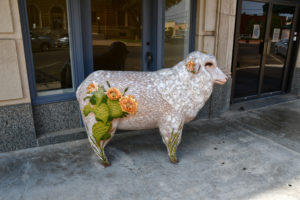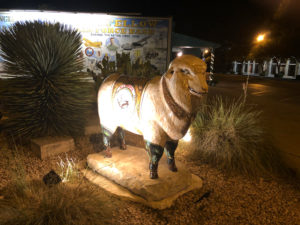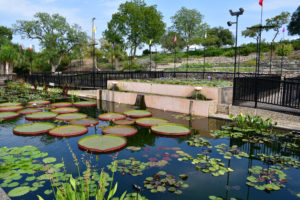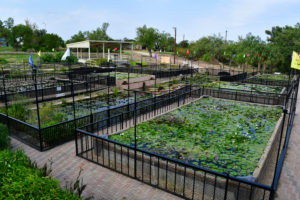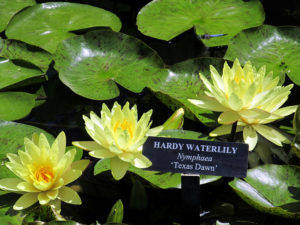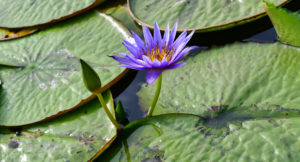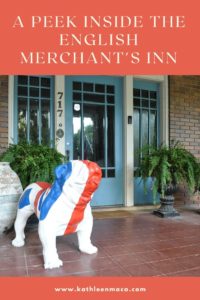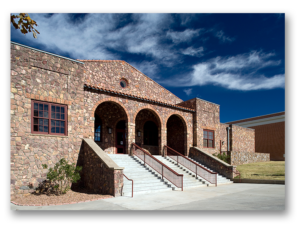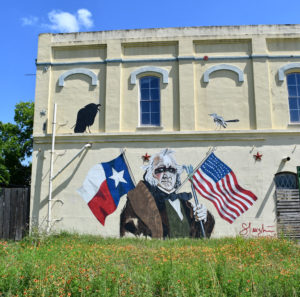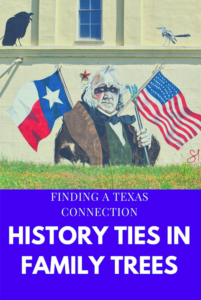Category: Roadside Attraction
Finding Fall in Lost Maples
Ah, fall: cool breezes, pumpkin patches and leaves changing colors….
Wait! Change of season colors in Texas? Yep, and I’m here to tell you exactly where to mark your map for a beautifully vivid fall trip.
Lost Maples State Natural Area is a pristine destination about five miles north of Vanderpool on Ranch Road 187. Typical of most state parks and natural areas, March through May are busy months due to the cooler weather.
 But Lost Maples’ most popular months are October and November when the foliage is ablaze in greens, reds, orange and gold.
But Lost Maples’ most popular months are October and November when the foliage is ablaze in greens, reds, orange and gold.
Uvalde big tooth maples, oaks, Florida basswood, American sycam ore, green ash, black willow, sugar hackberry and pecan trees tucked into limestone canyons carved by the upper Sabinal River provide the dazzling seasonal color. Add in an array of wildlife and seasonal wildflowers and this becomes one of the must-see autumn spots in the state.
ore, green ash, black willow, sugar hackberry and pecan trees tucked into limestone canyons carved by the upper Sabinal River provide the dazzling seasonal color. Add in an array of wildlife and seasonal wildflowers and this becomes one of the must-see autumn spots in the state.
Sound amazing? It is!
With over 2,900 scenic acres to explore you can fill your visit with hikes, picnicking, photography, camping, backpacking, fishing, geocaching and bird watching.
A birding guide for Lost Maples here.
 Fall temperatures at Lost Maples are mild, and the stargazing at night is jaw dropping. The sky looked like a sea of twinkling glitter. I used a handy phone app to identify some of the stars and constellations we spotted. You can find more information about the free app here.
Fall temperatures at Lost Maples are mild, and the stargazing at night is jaw dropping. The sky looked like a sea of twinkling glitter. I used a handy phone app to identify some of the stars and constellations we spotted. You can find more information about the free app here.
Stop into the ranger station at the entrance parking lot for a small but interesting  display about Lost Maples, and don’t forget to pick up a free trail map to set your course. There are ten miles of well-maintained hiking trails, including a challenging, steep seven-mile loop that takes you along the top of a 2,200 foot cliff.
display about Lost Maples, and don’t forget to pick up a free trail map to set your course. There are ten miles of well-maintained hiking trails, including a challenging, steep seven-mile loop that takes you along the top of a 2,200 foot cliff.
Even on the easiest trails, you’ll enjoy seeing steep canyon walls, streams, ponds and rocky bluffs.
Remember to take plenty of water and normal hiking supplies like sunscreen and a small first aid kit.
Dogs are welcome, but if they’re hiking along with you be sure to bring their water. It’s a workout for them, too.
 I was intent on finding Monkey Rock during
I was intent on finding Monkey Rock during  my hike, one of most photographed spots in the park year round, and was grateful to find several signs indicating the general route to him. Just follow the marked trail and as you come into a clearing by the bluffs, look up! There’s no mistaking his toothless grin.
my hike, one of most photographed spots in the park year round, and was grateful to find several signs indicating the general route to him. Just follow the marked trail and as you come into a clearing by the bluffs, look up! There’s no mistaking his toothless grin.
I dare you not to smile when you spot him.
In addition to reptiles and insects (even tarantulas!), keep an eye out for an array of birds, gray fox, white-tailed deer, armadillos, raccoons, bobcats, squirrels and an occasional javelina. Most of the wildlife will understandably avoid people, but the more tranquil (quiet!) your walk, the better chance you have of spotting them.
for an array of birds, gray fox, white-tailed deer, armadillos, raccoons, bobcats, squirrels and an occasional javelina. Most of the wildlife will understandably avoid people, but the more tranquil (quiet!) your walk, the better chance you have of spotting them.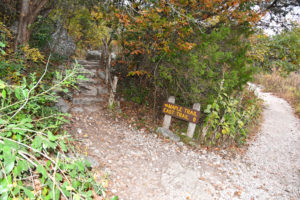
If you only have half a day or so, I recommend prioritizing a hike along the Maple Trail, to Monkey Rock and the Grotto with its ferns and drip springs, with a short detour to the waterfall.
Taking time for a picnic lunch and skipping stones across one of the ponds is guaranteed to wash away stress.
When hiking, remember to stay on the trails to preserve the natural habitat. Water can sometimes cross the trails during heavy rains.
Remember that you’re in a canyon, so don’t expect cell phone reception inside Lost Maples. It’s a great opportunity to disconnect from the world and enjoy nature.
The park only accommodates about 250 cars, so if you go during the peak season you’ll want to arrive early to claim your spot.
 Weekends fill up fast with only 300 guest slots available from 8 a.m. until noon, and another 150 spots from 1 p.m. to 5 p.m. Once you’re there you can stay until 10 pm.
Weekends fill up fast with only 300 guest slots available from 8 a.m. until noon, and another 150 spots from 1 p.m. to 5 p.m. Once you’re there you can stay until 10 pm. 
 Here’s the secret: you can actually purchase a Save the Day pass 30 days in advance online! When I chose the dates of my visit I counted backward on my calendar and jotted myself a reminder to book as soon as the dates were able to be claimed.
Here’s the secret: you can actually purchase a Save the Day pass 30 days in advance online! When I chose the dates of my visit I counted backward on my calendar and jotted myself a reminder to book as soon as the dates were able to be claimed.
As with most popular destinations, weekdays are less crowded. My friend and I went on a weekday to avoid the weekend crush and were thankful to have the trails virtually to ourselves.
 Another insider tip: Though the last two weeks of October and the first two weeks of November are traditionally the height of the fall color season, this can vary from year to year due to weather patterns. Be sure to check resources like the fall foliage conditions for the most current updates. A link is here.
Another insider tip: Though the last two weeks of October and the first two weeks of November are traditionally the height of the fall color season, this can vary from year to year due to weather patterns. Be sure to check resources like the fall foliage conditions for the most current updates. A link is here.
When you’re ready to satisfy that appetite you’ve earned after a wonderful day of hiking and exploring, check out the nearby Lost Maples Café in Vanderpool. Click the name for more details.
My only regret is that Lost Maples was on my wish list of destinations for so long before I actually made time to go. Now I can’t wait to go back and take others along!
Water Lilies of San Angelo
Bet you didn’t know that Texas has an official state water lily…
I mean, c’mon. There’s pretty much a state EVERYTHING of Texas, so why not this?
And I’ve discovered the ideal place to see it in person: The International Waterlily Collection Garden in San Angelo.
For over thirty years, visitors to this unique outdoor space have been stopping to admire the fascinated flowers and lily pads. Ho hum, you say? What if I told you that some of the pads are eight feet in diameter!
A rainbow of blooms of up to 150 species inhabit six pools. What’s even more amazing is that the varieties on view are only about 1% of owner Ken Landon’s collection, which encompasses close to 90% of all water lilies, including some that have become extinct in their native lands. The types in the pools are changed annually, and signs identify many of the species.
My husband and I had so many thing on our “to see” list while we were in San Angelo, that I admit this park fell into the “if we have time” category. Thank heaven we did! The descriptions of it that I hadn’t done it justice.
 Dozens of dragonflies and birds flitted around the pools and flowers, which made it even more enchanting.
Dozens of dragonflies and birds flitted around the pools and flowers, which made it even more enchanting.
The long flowering season of the waterlilies (from April to October) provides ample opportunity to see them but the height is September, which is when San Angelo’s Lily Fest is! Click this link for updates about the festival.
The best time to see the flowers is in the morning, but some of the blooms only occur in the evening.
But what about the Texas State Water Lily? I’m glad you asked! On April 26, 2011, the 82nd Legislature of the State of Texas formally designated Nymphaea, “Texas Dawn” as the Official Waterlily of the State of Texas. San Angelo is home to the “Texas Dawn,” which was created by Landon.
The International Waterlily Collection has been designated by the International Waterlily & Water Gardening Society as a premiere collection of lilies in existence. Pretty impressive, huh?
The display is near the corner of West Beauregard Avenue and North Park Street west of downtown San Angelo and the Concho River. The park is free to the public and open 24 hours.
So put the ‘petal to the metal’ (sorry!) and be sure to add this colorful, unique stop to your next visit to or through San Angelo.
Ponder-ing Bonnie & Clyde in Texas
Since Bonnie Elizabeth Parker and Clyde Chestnut Barrow were both born in Texas, it should come as no surprise that there is no shortage of places in the state with some sort of link to the notorious outlaws. 
When Bonnie, Clyde and the Barrow Gang drove up to the Ponder State Bank in Ponder, Texas and attempted to rob it, they were disappointed to find out it had gone bankrupt the week before. Legend has it that Cl yde was so disgusted with the news that he marched the teller out to the getaway car at gunpoint, and ordered him to repeat what he had just said to Bonnie…who laughed hysterically. Clyde then shot out the windows of the bank in frustration.
yde was so disgusted with the news that he marched the teller out to the getaway car at gunpoint, and ordered him to repeat what he had just said to Bonnie…who laughed hysterically. Clyde then shot out the windows of the bank in frustration.
Years later in 1967 Warren Beatty and Faye Dunaway would film a reenactment of the event at the same bank while portraying the young outlaws. The fil m, which told a version of their story that is far from the truth, glorified the couple as being glamorous outlaws. In reality they murdered at least thirteen people.
m, which told a version of their story that is far from the truth, glorified the couple as being glamorous outlaws. In reality they murdered at least thirteen people.
This popular movie is actually why most people refer to them as “Bonnie and Clyde.” In their day they were more commonly referred to as the Barrow Gang or Clyde Barrow and “that Parker woman.”
The Ponder bank is empty now, but still has much of it’s original charm including the original teller cage and bank safe.
 I love when movies about historical characters are able to use actual locations from their (sometimes fictionalized) lives, don’t you?
I love when movies about historical characters are able to use actual locations from their (sometimes fictionalized) lives, don’t you?
If you stood on these steps would you be more impressed that you were standing where Bonnie & Clyde did, or Warren and Faye?
Dancing to Ditties Down on Double Bayou
A few miles south of Anahuac in the community of Double Bayou in Chambers County, aptly named for its location nestled between two bayous, a long narrow building sits beside moss draped oaks hinting at the much livelier days of the past.
Don’t let appearances fool you though, this place was once a hoppin’ joint!
 Double Bayou Dance Hall was built in the late 1920s using cedar logs as a dance floor, hog wire and wood for the walls topped by a tin roof. The tacks and staples that held tar paper covering can still be seen on the exterior wood.
Double Bayou Dance Hall was built in the late 1920s using cedar logs as a dance floor, hog wire and wood for the walls topped by a tin roof. The tacks and staples that held tar paper covering can still be seen on the exterior wood.
During Juneteenth in the 1920s and 30s, many revelers would come to the “The Place,” as it was known locally, all the way from Galveston. The celebration often lasted three days, but always ended in time for Sunday school and church.
A storm destroyed the original hall in 1941, but Manuel Tanzy Rivers (“Rivers”…appropriate name, don’t you think?) used the original materials to rebuild it just down the road in 1946 after returning from after World War II. The hall served as a gathering place for community events during the week, and a dance hall on the weekends.
The hall was on the ‘Chitlin’ Circuit’ for the next couple of decades. The circuit, which gained notoriety in an interview with Lou Rawls, was a group of performance venues in the South that were safe for African American musicians to perform during the Jim Crow era. Major acts on their way to Houston would often detour to play impromptu gigs at the famous hall.
The audiences at Double Bayou came from all different ethnic, cultural and economic backgrounds to share their love of music and the Texas Blues arriving by boat, automobile or on foot from local towns, Houston, Galveston and Austin.
Rivers’ nephew, blues guitarist Floyd “Pete” Mayes and his band the Texas Houserockers played their first professional gig at the Double Bayou Dance Hall in 1954, and soon became the house band playing there through the early 1960s.

Mayes took over the dance hall after his uncle passed away, and in later years hosted jazz, rhythm & blues and zydeco concerts there in between his performances around the nation. In the old days, zydeco was called “La-la’ and would often include an accordion and rub board (frottoir) or sometimes a fiddle and a rub board.
From 1955 until 2005 Mayes hosted a Christmas matinee that became a traditional excursion for many music loving Texans. Cowboys would smoke brisket on the lawn and local women offered homemade pecan, lemon meringue and sweet potato pies as music drifted out the doors and windows and into the surrounding trees.

Mayes and his band recorded a CD titled “Pete Mayes and the Texas Houserockers LIVE! At Double Bayou Dance Hal l in May 2003. Treat yourself, and listen to a snippet of one of the tunes HERE.
l in May 2003. Treat yourself, and listen to a snippet of one of the tunes HERE.
Mayes passed away in December 2008. Just three months earlier Hurricane Ike’s 20-foot storm surge washed over the Bolivar Peninsula and swept north, flooding the Double Bayou area. The storm broke walls and damaged the roof, but left the dance hall damaged but standing.
 Today the ruins stand behind a Texas State Historical Marker, with the falling roof and broken floorboards sheltering snakes and spiders rather than musicians.
Today the ruins stand behind a Texas State Historical Marker, with the falling roof and broken floorboards sheltering snakes and spiders rather than musicians.
The only music that echoes through the windows and doors these days is the wind and rustle of leaves.
Virtual Travel: Waxahachie, Texas
This week we had a quick visit and virtual tour of the English Merchant’s Inn in Waxahachie . . . one of my favorite bed and breakfasts in Texas. If you missed it, you can catch the replay below, then refer to the links below for more fun to be found in this gem of a small town.
Click these links to find more information and photos:
English Merchant’s Inn
Waxahachie Courthouse Folklore
Hachie Hearts
Waxahachie’s Love Lock Bridge
Diggin’ Up Fun at the Museum of the Big Bend
What to do while we’re quarantined? Well, just travel virtually that’s what!
Here’s a link to the instagram visit I had with Matt Walter, Curator of Collections at The Museum of the Big Bend in Alpine, Texas. Just click the link and come along!
Thanks so much, Matt!
O.K, friends – What was your favorite item or exhibit on the tour?
Sam Houston’s Wife and a Kindred Connection
Texan artist Tra Slaughter painted this mural of Sam Houston on the back of a building in downtown Brenham, facing the railroad tracks. If this image of Houston seems odd to you, you may not be familiar with his connection to the Cherokees.
In 1809 at the age of 16, Sam Houston ran away from home in Tennessee and lived among the Cherokees. He was adopted by Chief Oolooteka and given the name Colonneh or the Raven.
 Although I grew up in Texas, I first heard about this other name while attending the university named after this Texan forefather. The name cropped up often around Huntsville in business names.
Although I grew up in Texas, I first heard about this other name while attending the university named after this Texan forefather. The name cropped up often around Huntsville in business names.
While I was learning more about Houston, I found that his Cherokee wife’s name was Talahina “Tiana” Rogers . . . a name that sounded pretty darn familiar to me. Always fascinated with my mother’s Cherokee lineage, I started researching her genealogy when I was just 12.
sounded pretty darn familiar to me. Always fascinated with my mother’s Cherokee lineage, I started researching her genealogy when I was just 12.
Sure enough, Talahina‘s great grandparents William Emory and Mary Suzannah Grant were my seventh great grandparents. So while it is a distant connection, I was happy to learn that I had a personal link to this fascinating woman.
Talahina’s mother Elizabeth was the sister of my 6th great-grandmother Susannah. Both were born in Houston’s home state of Tennessee to William and Mary Emory.

Sam Houston had three wives, but for obvious reasons, this one is a special interest of mine.
This mural is spectacular, and also features an actual raven and a Mockingbird, the state bird of Texas. Art is such a terrific way to relate pieces of history.
Have you done any research on your family tree? You never know what or who you’ll find.
Birdwatcher Alert: A Phoenix on Galveston
What’s 15 feet tall with a 35-foot wingspan and gleams in the sunlight? A metal statue of a Phoenix created by Houston based artist Bob Bacon that now guards the gate of his brother’s Galveston ranch.
Bacon’s creation first appeared in the 2017 Houston Thanksgiving Day Parade, after he created it as a post Hurricane Harvey symbol of hope and recovery.
Since it’s big debut, the statue has been nesting in a warehouse, waiting for its next chance to take flight.
 The onset of the coronavirus pandemic inspired the family to install the phoenix on Galveston Island to once again provide a symbol of hope. The Bacon Ranch is an appropriate home for this particular piece of artwork, since most of the land on the ranch has been set aside as grounds for the migrating birds that pass over Galveston Island each year.
The onset of the coronavirus pandemic inspired the family to install the phoenix on Galveston Island to once again provide a symbol of hope. The Bacon Ranch is an appropriate home for this particular piece of artwork, since most of the land on the ranch has been set aside as grounds for the migrating birds that pass over Galveston Island each year.
The family welcomes visitors to pull along the side of the road to get a close look and photos, but asks that no one trespass beyond the fence.
To visit, travel west from Galveston on FM 3005 past Jamaica Beach, and look on the north side of the road.
No binoculars required!
Texas’ First White House: The Ross Sterling Mansion
This morning I posted a photo and bit of information about the Ross Sterling Mansion, which is known locally as the First Texas White House. After receiving several messages asking for a bit more information, I’m sharing it here.
This beauty is right down the road from my own home…which is decidedly smaller!
Architect Alfred C. Finn designed the scaled down replica of the American White House for Humble Oil founder and future Texas governor Ross Sterling. It’s a Texas State Historical Landmark as well as being listed on the National Register of Historic Places.
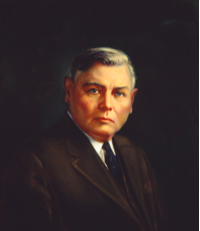
Finn, by the way, also designed Houston’s Jefferson Davis Hospital, Sam Houston Coliseum, and the San Jacinto Monument in addition to numerous other federal and private projects.

 Construction on the grand residence began in 1924 and was completed in 1927. First named “Miramar” – meaning “sea view” – the 21,000 square foot mansion sits on six about six and a half acres of residential coastline between La Porte and Morgans Point.
Construction on the grand residence began in 1924 and was completed in 1927. First named “Miramar” – meaning “sea view” – the 21,000 square foot mansion sits on six about six and a half acres of residential coastline between La Porte and Morgans Point.

Its 34 rooms include nine bedrooms, 15 baths, a dining room that seated 300 guests, a ballroom with pressed tin ceiling and marble fireplace, a gentleman’s lounge with carved wood fireplace and built-in leaded glass-front bookcases, a mahogany-paneled library, a ladies’ parlor, and a kitchen with butler’s pantry. Seven fireplaces warmed the waterfront home on chilly winter evenings, and the rooftop terrace still offers stunning 360-degree waterfront views.

This pair of serpentine reversed staircases in the foyer would put the most stunning movie set to shame.

The waterfront side of the home features a 28-foot columned rotunda portico that most people immediately recognize as being based on the White House.


The staircases and lowest level are made of granite blocks, and the walls of the upper stories are made of foot-thick limestone. The foundation is reportedly strong enough to support a ten-story building. The stalwart structure has withstood countless storms including Carla, Alicia, and Ike. I would certainly feel safe within its walls!

Ross Sterling was the 31st governor of Texas, serving from 1931-1933. Countless dignitaries and celebrities have been hosted in the home over the years.

Sterling and his wife Maude Abbie Gage had several children, and they along with a generation of grandchildren enjoyed the home for two decades.

In 1946 he donated his mansion to a civic club and it was used as a juvenile home until 1961. During those years the home suffered heavy damage.

Thankfully a handful of owners in the interim years have restored it to its former glory. It still retains many of the original features including intricately carved and gilded moldings, silver and gold light sconces, Tiffany chandeliers, antique stone fireplaces, pressed-tin ceilings and marble and oak flooring.
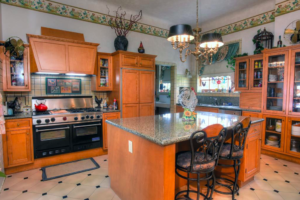
It is now once again a private residence, having sold at auction in 2016 for $2.8 million (though initial estimates were for $4 million).
If the current owners insisted on having me over for tea, I must admit I wouldn’t mind!
If you’d like to cruise by on a Sunday drive, the historic home is located at 515 Bayridge Road in LaPorte.

Click the links below to watch some entertaining home movies shot at the mansion back in it’s Fitzgerald-era heyday!






